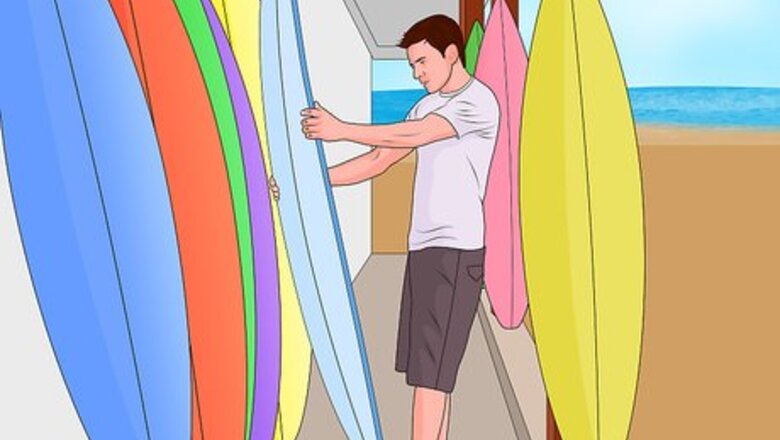
views
Getting the Right Gear
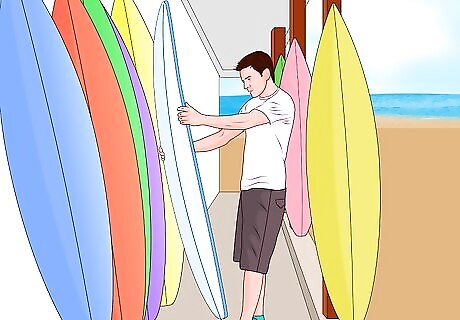
Rent a soft surfboard your first time out. Don't invest in your own surfboard if you've never tried surfing before. At most beaches good for surfing, rental spots will be available close to the beach, offering reasonably cheap rental options, by the hour or by the day. You'll usually be able to choose between fiberglass boards and soft surfboards, sometimes called “soft tops” or "foamies." Soft surfboards are lightweight and much cheaper than epoxy or fiberglass boards. Soft boards are extremely buoyant and durable, making them a good choice for beginners. Your size and weight will contribute to determining which type of board you should learn on. The more weight you have, the bigger the board volume you will need. You may not have a good experience learning to surf if you are trying to learn on a board that is too small for you. If you're not sure what you want, talk to people at the surf shop. Be honest and tell them that you're a first-timer and you want to know what you need to get started.
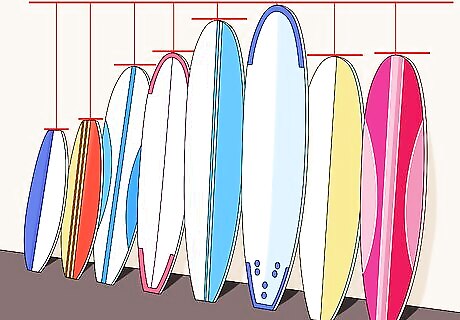
Try out a longboard while you're first learning. Longboards are the oldest and longest type of surfboard commonly available, ranging from 8 to 12 feet (2.4 to 3.7 m) in length. While they're not quite as maneuverable or versatile as other types of boards, longboards are often recommended for beginners because of their ease of use. The more volume a longboard has, the easier it is to balance and paddle into waves. This makes for more enjoyable experiences for most learners. If you've tried a longboard and want something a little more maneuverable, you should try a funboard. Funboards are hybrid boards which are a bit shorter than longboards, typically 7–8.5 feet (2.1–2.6 m). Funboards combine the smoothness and stability of a longboard with some of the agility of a shortboard.

Work your way up to a shortboard. Shortboards are less than seven feet long, with a sharp nose and multiple fins. It takes more practice to master a shortboard than longer types of surfboards, but it is considered the definitive high-performance board for the pros (though some professional surfers use longboards as well). Fish boards are even shorter than shortboards and much wider. The fish board’s flatness and small profile make it ideal for riding small surf that other boards sometimes struggle with. It's a great board for intermediate and advanced surfers. Alternatively, The gun is another more advanced board. These boards are thin boards with very thin noses designed for experts surfing the very biggest waves. It can handle steep drops and high speeds with ease, but it’s hard to control if you're a beginner.
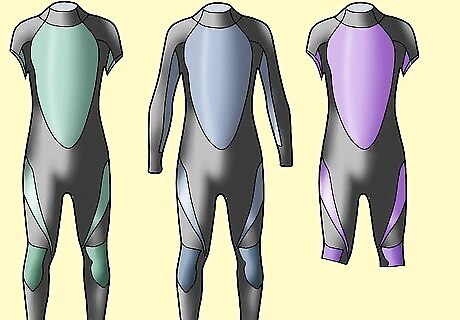
Get a wetsuit. In many places, a wetsuit is just as essential as the board itself to ensure an enjoyable surfing experience. The wetsuit keeps your body warm in cold water, helping prevent chills and hypothermia. If the local surf shop recommends a wetsuit, get fitted and rent or purchase one before you hit the beach. It does depend on where you are though as if the water is not cold enough you will overheat and wetsuits can restrict your movement and should only be used in really cold water.
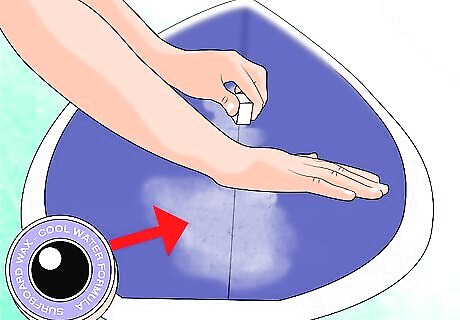
Get some surfboard wax. Surfboard wax is an important and inexpensive product that can be rubbed onto the top of a surfboard to increase foot grip, allowing better balance in the water. Ask your surf shop which type is appropriate for the temperature of the water you will be surfing in. Make sure not to get the wax sandy! This makes it very abrasive and can hurt your stomach.
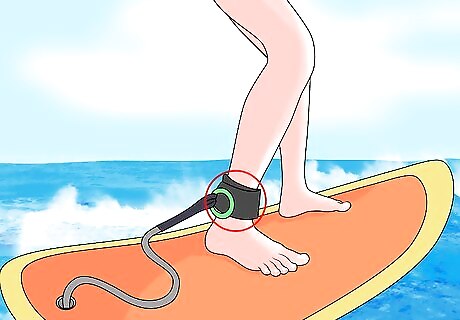
Get a leash for your board. A leash keeps you and your board from separating in the water. If you wipe out, you don't want to be stuck out in the breaking waves without a board. You also don't want your board floating freely into other surfers or smashing up against the rocks. A runaway board can be very dangerous for anyone in the water, not to mention potentially costly. Also, be sure to have a leash string, which connects your leash to the leash plug located at the tail of the board.
Getting Started
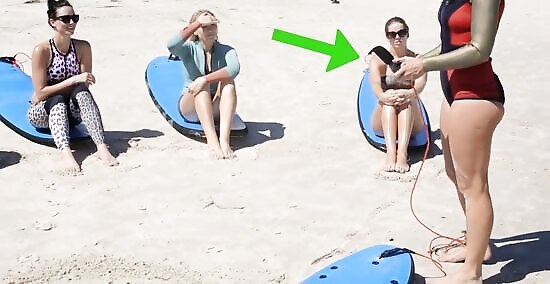
Practice on the ground first. Attach the leash to your back foot and to the tail of your board, then lie belly-down on the board so that your body is lined up straight down the middle of the board. From this position, practice your paddling motion with both arms to get a sense of the muscles that you will be working. If you're right-handed, your back foot will generally be your right foot. This is called "regular" stance. It's called "goofy" stance when the leash is on your left foot. When in doubt, just do what feels most natural. Don't just jump into the water when you're first learning to surf, or you'll get frustrated quickly. Take a little bit of time to practice on the sand, or in the privacy of your backyard, before you're on the beach in front of others.
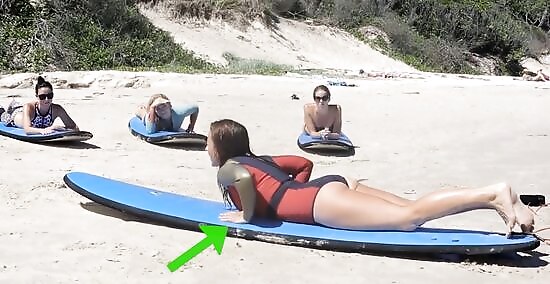
Practice getting up. "Taking off"(or “popping up”) on the wave and standing up on the board takes a bit of practice. While lying on the board, bring your hands up from paddling and place your hands below your chest, palms on the flat of the board while your fingers curl over the sides of the surfboard. In one quick motion, push your body up with your arms and tuck your feet up and under you. Place one foot where your hands pushed up from and the other at least a shoulder’s width behind. As you are beginning, you may find it easier to get up to your knees first and then bring up one foot at a time until you are in a standing position. It's slower than the jump up, but it works effectively for someone not ready for the jump up. Never grab the rails, or edges, of the board during your take off, unless you want to get a nice gash on your chin when your hands slip off your rail. If you find your hands or feet slipping when you try to get up, you may need to rub more wax on your board. You can practice jumping up without a surfboard present, so feel free to do it wherever you have a bit of space until you feel comfortable doing it.
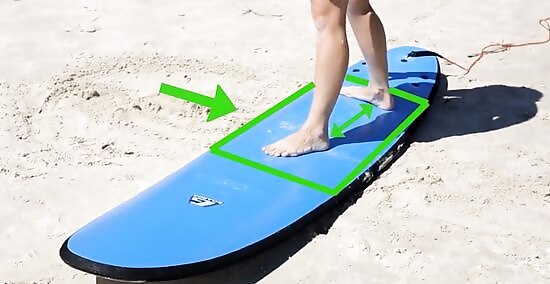
Learn to stand on the board properly. Once you've taken off, keep your knees bent, your arms loose and extended, your feet planted on the board, and your torso leaned forward to lower your center of gravity. Depending on which foot comes naturally in front, you'll be either a "regular foot" or "goofy foot." Regular foot means that your left foot is in front, while goofy foot means your right foot leads. Beginners have a tendency to adopt a squatty stance when learning. Their feet are widely spread apart from bow to stern of their boards. This might feel comfortable, but it actually makes it harder to control. Balance is side-to-side, not front to back. You will notice that experienced surfers usually ride with their feet much closer together. A proper stance includes keeping your eyes looking in the direction you are going.
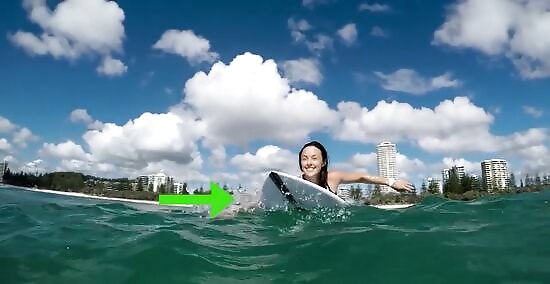
Paddle around and get comfortable in the water. The only way to find the "sweet spot" on your board is to take it into the water and paddle. Your board should plane across the water, the nose slightly above the water. A good “go-to” balance position is having your toes touching the leash string. If your nose is too high up, you're too far back on the board. If it digs water, you're too far forward. It is essential to find the sweet spot, as that is where you will achieve maximum paddling efficiency. Paddle with long, deep strokes from as far forward to as far back as you can comfortably reach.
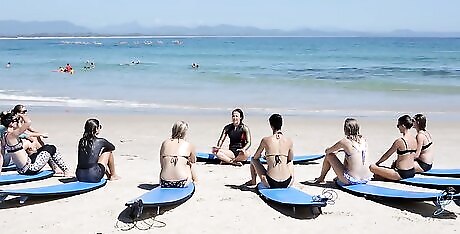
Talk to more experienced surfers or instructors if you can. The best way to practice and prepare for hitting the beach is with another person nearby who knows more about surfing than you do, and can provide feedback and advice. If you have a friend who surfs, ask for help. Friends don't usually charge and you can practice privacy of your own home rather than on the beach in front of others. Pay an instructor. This is the most reliable way to learn the basics of surfing in a clear, methodical way. For a fee, he or she will teach you all you need to know and give you pointers that will help you get out into the surf and having fun quickly.
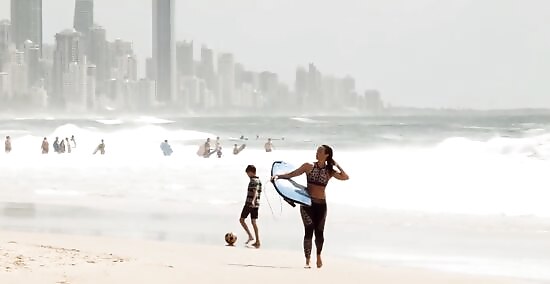
Find a spot. Before you plan to surf, visit a couple good surfing beaches and take a good long swim to make sure you feel confident in the water. Never surf anywhere you aren't comfortable swimming on your own. Ask around for advice. Ask your local surf shop or surfers at advanced surf breaks where beginners should surf. They will be happy to point you to an appropriate spot. Check online. If you can't find any advice that seems reliable, go online and search for recommendations there. You will often be able to find discussion boards for local surfers that have good information. Play it safe. If there is a lifeguard tower, plan to surf at a time when the lifeguard is on duty. Take some time to ask other surfers on the beach if they have any advice or warnings for you.
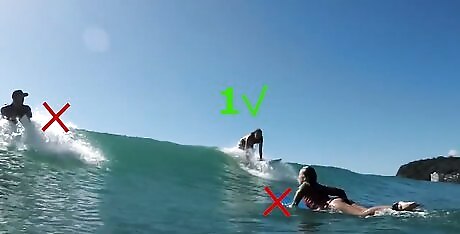
Learn basic surfing etiquette before you head out. Knowing the basic rules of the surf will help you make sure that your first time out is fun and safe. Here are a few basic safety rules to keep in mind: Respect the right of way. When there is more than one surfer paddling to catch a wave, the person who has paddled closest to the peak has the right of way for that wave. Don't "drop in" on others. Paddling to catch or dropping into a wave while someone is already riding closer to the peak is considered rude and potentially dangerous. Remember to scan the line of the wave for other surfers before you try to catch it. Very popular and busy beginner surfing locations don't usually have these strict rules and multiple people will often ride the same wave (sometimes referred to as a "party wave"). If two people are waiting on the same wave, whichever person catches it first and is closer to the peak has the right of way.
Catching a Wave

Identify a target spot. You want to be waist deep in the white water, where the waves have already broken. This is the best place to start when you're a beginner. Don't plan on paddling too far out where more advanced surfers might be waiting for a set, but make sure you are in deep enough water to keep from hitting your head if should you fall off your board. Pick a reference point. Choose a landmark on the shore and glance at it periodically as you move into deeper water. This will help you gauge your distance from shore, and can help to reveal any hidden currents that might be moving you.

Paddle to your spot. When you're ready to go out into the waves, walk your board out until you're about waist- or chest-deep, then lie on the board and paddle straight into the waves. Paddle straight when you are paddling out. If you hit the waves at a glancing angle, you will lose the forward momentum you've built up. Stay perpendicular to the oncoming waves and “cut” through them instead. As you “cut” through a wave, it helps to do a push-up with your upper body as you go over or through the wave. This prevents the wave from pushing you back to shore.
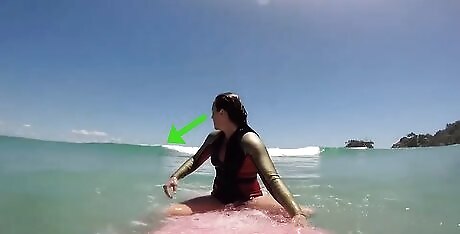
Turn your board and wait for an appropriate wave. Sit back on your board until the nose is up out of the water. Kick your legs in an egg beater motion to turn the board around toward the shore. Position yourself in your sweet spot and get ready to paddle for the wave using long, smooth, deep strokes. When you see a wave coming, get into position as near the peak as you can without appearing to be a "wave hog." When you are satisfied that you are in a good position to catch the wave, paddle like there's no tomorrow and give it all you've got!
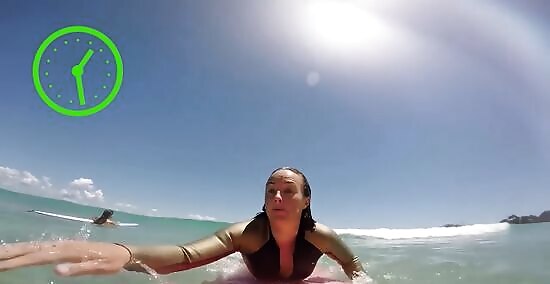
Start paddling and try to catch the wave. When you have a good sense of the speed and motion of the wave and you feel that sense that you've caught its momentum, take off using the techniques you've been practicing. Keep looking forward as you paddle. When you turn around, you lose power. Be quick. You want to catch the wave before it breaks, so you have time to get up on the board. It is often common for beginners to catch and ride the “white water” (which is a fine way to begin). Be patient. If you miss a wave, just paddle back out and wait for the next likely candidate.
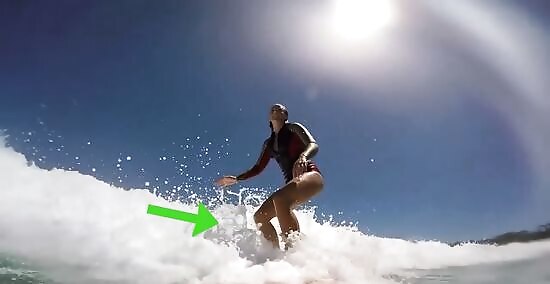
Ride the wave. Keep your feet planted on the board, your knees bent, your arms loose, and your eyes looking in the direction you are going. You're now surfing your first wave! Stay focused and let it carry you in to shore. Keep an eye out for others in the water while you are surfing. Start simple. At first, you should ride each wave straight in. This is a shorter and slower way to ride than angling on a wave, but it is easier to get the hang of.

Try turning when you're ready. As you become accustomed to the feeling of surfing, you will probably want to try angling your board across a wave. Lean into your turn with your body, keeping your center of gravity on the board. Use your body to gently dip one rail of your board into the face of the wave. This creates friction/drag that will turn the board. Once you catch the right angle, maintain balance and ride down the curl of the wave. Pick the direction you want to ride across the wave (left or right) early. If the wave is low enough, begin paddling in that direction before the wave hits. For larger waves, wait until you are getting pulled up onto the wave.
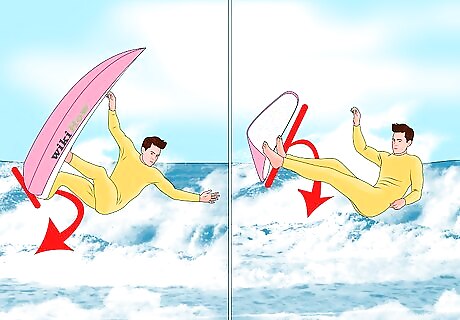
Be prepared to wipe out. If you feel yourself falling, or if the wave dies down, jump away from the board towards the ocean and away from your momentum. A good idea is to fall to the side or the back of the board, covering your head with your arms as you fall. Go with the flow, letting the wave carry you. Swim upwards gently and feel what’s ahead of you to avoid getting hit by the board. Try to land flat so that you won’t injure yourself in shallow water or on a reef. Once you have safely surfaced, pull your leash and climb back onto your board to prevent it from scything or flopping through the water, which can cause serious injury to you or others. Climb aboard, rest on your belly, and regain control. Most wipe out injuries happen as a result of the board hitting the surfer. Always remember to bail to the ocean side of your board. You don't want to be between the beach and your board when a wave has control of the board. If you are riding for the very first time, it's great to rent a foam surfboard rather than a fiberglass one, as they are softer and less likely to cause you injury while learning.
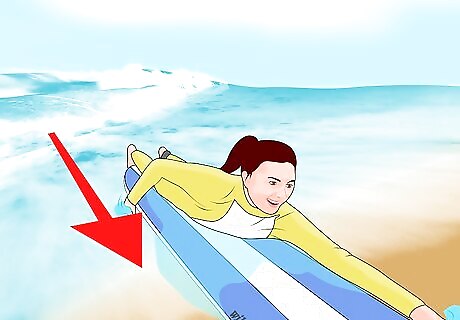
Use the channels to get out of the way. After you wipeout or bail, you need to get out of the way so that other people can surf. Don't paddle up the middle of the break where other surfers will be coming. Instead, paddle off to the side first, to keep the wave zone clear.
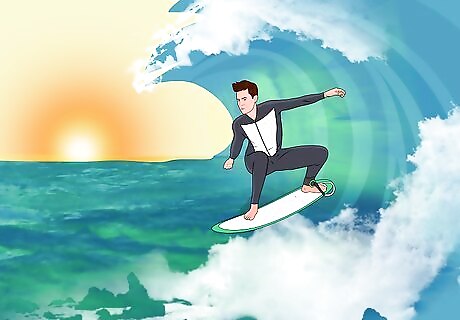
Keep trying. You'll probably slide or fall off the first few times, but don't be deterred. Some people can learn in an afternoon, while others take a few weeks to get the hang of things. Keep trying and you'll eventually make it. Avoid getting to your knees and stopping. If you're going to commit, commit and stand up. Going to your knees is like saddling the horse but not riding it. Enjoy the ocean and have fun.


















Comments
0 comment